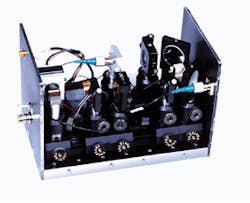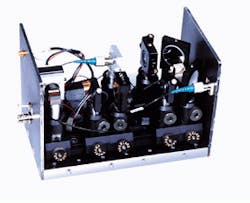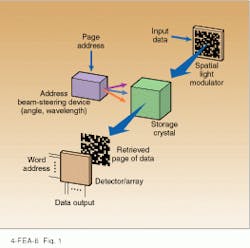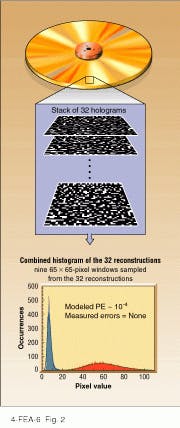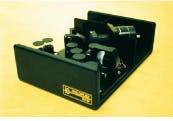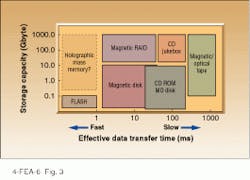Dense holographic storage promises fast access
Dense holographic storage promises fast access
With three-dimensional recording and parallel data readout, holographic memories can outperform existing optical storage techniques.
John H. Hong and Demetri Psaltis
In its basic form, a hologram is the photographic record of the spatial interference pattern created by the mixing of two coherent laser beams. One of the beams usually carries spatial information and is labeled the "object" beam. The other is distinguished by its particular direction of travel and is labeled the "reference" beam. Illuminating the recorded hologram with the reference beam will yield or reconstruct the object beam and vice versa. As the holographic material becomes thicker, the reconstruction becomes very sensitive to the particular angle of incidence of the reference beam, which allows multiple objects to be recorded in the same volume and accessed independently by using an appropriate set of associated reference beams. Such holograms would be recorded sequentially, each object beam illuminating the holographic material simultaneously with its unique reference beam.
The angularly selective property of holograms recorded in thick materials (typically 1-10 mm thick) enables a unique form of high-capacity data storage distinguished by its parallel data access capability. A holographic data storage system is fundamentally page-oriented, with each block of data defined by the number of data bits that can be spatially impressed onto the object beam. The total storage capacity of the system is then equal to the product of the page size (in bits) and the number of pages that can be recorded.
A holographic data storage system can be constructed to exploit this principle by using a spatial light modulator to properly shape the object beam, an optical beam scanner to point the reference beam, a detector array to convert the reconstructed output object data into an electronic bit stream, electronics to control the entire process and condition the input/output electronic information, and a sufficiently powerful laser to overcome the optical losses of the system (see Fig. 1).
In practice, the number of holograms that can be stored and reliably retrieved from a common volume of material is limited to less than 10,000 so that spatial multiplexing techniques must be used. Although solid-state designs are possible, it is easiest to envision a storage material formed as a volume disk in which holograms in a particular cell are stored and retrieved by angular multiplexing and where random access to arbitrary cells is enabled by rotation of the disk (see Fig. 2).
Demonstration systems
The holographic 3-D disk being developed at the California Institute of Technology (Caltech) is a practical example of such a system. The 3-D disk shown in Fig. 2 has a 100-µm-thick photopolymer laminated onto a glass disk substrate. By superimposing 32 holograms--each hologram consisting of 590,000 bits--in an area 1.77 mm2, an areal density greater than 10 bit/µm2 has been demonstrated. No errors were detected in the reconstructions. Thicker recording media can yield densities in excess of 100 bit/µm2.
Another example is a system demonstrated at Rockwell that has no moving parts and is based on an acousto-optic addressing scheme (see photo on p. 119). Rockwell is developing the technology for avionics applications in which resistance to vibration and shock must be provided while maintaining the beneficial features of holographic storage. In addition to such technology demonstrations, Holoplex (Pasadena, CA) has recently developed and delivered a commercial holographic memory product that stores up to 1000 images, each consisting of 640 ¥ 480 pixels, and is capable of reading out its entire contents in one second (see Fig. 3).
Holographic data-storage systems use devices that are currently being refined by display and electronic imaging applications, so cost reductions and performance improvements can be expected in some proportion to the large volumes expected in those markets. Some of the key components, such as the spatial light modulator (used to compose a given data page) and the electronic detector array (which converts the holographic data reconstruction into an electronic bit pattern or data stream) have matured to the level that now allows one to contemplate megapixel arrays--again driven by very large consumer markets involving display and imaging devices.
New compact visible wavelength laser sources such as high-power semiconductor and frequency-doubled solid-state lasers are also available for use in holographic systems. Further optical and system engineering, including error correction and other issues, however, is needed to integrate such devices into demonstration systems. Several entities, including Holoplex, Caltech, Tamarack (Austin, TX) and the Holographic Data Storage System Consortium (which includes IBM, Rockwell, Kodak, GTE, TI, SDL, Rochester Photonics, Optitek, Stanford, University of Arizona, Carnegie Mellon University, and the University of Dayton) are currently working to integrate such devices and materials into successful demonstration systems (see Laser Focus World, March 1996, p. 38).
Mass memory applications
Mass memory systems serve computer needs by providing archival data storage; emerging applications also involve network data and multimedia services. In general, such systems require high capacity and low cost relative to on-board random access memory (RAM). A variety of hardware approaches are currently available and can be classified with respect to two important performance measures: storage capacity and effective data transfer time (see Fig. 4).
The effective data transfer time is a measure of the time required to fully retrieve an arbitrarily located data block from the system and is a combination of the data transfer rate (the rate at which data are transferred from the mass memory to the user or CPU) and the data latency (the time lag between the address set-up and the appearance of valid data at the output). The effective data transfer time is given by the sum of the data latency and the data block size in bytes divided by the data transfer rate in bytes per second. For specific comparisons, the block size must be chosen with care depending on the application of interest. No matter how fast the data transfer may be, a fundamental limitation exists for all approaches involving mechanical motion of either the read/write head or the storage medium.
Magnetic and optical tape storage systems are cost-effective for archival storage, when data access time is less critical. At the other extreme, flash memory, which is a solid-state semiconductor approach, offers extremely fast data access time at relatively low packing density but at high cost. Although incremental im provements to existing disk-based systems may be sufficient to address certain new applications, such as digital video CD-ROM, they will fall short of addressing applications in which both high capacity and short effective data transfer time are featured simultaneously, as is the case with network servers and image databases.
A new storage technology must displace the incumbent in all other portions of the storage spectrum. To do this, the demands of a mature market must be met, as well as technical challenges. New technologies that attempt to increase only the achievable storage capacity must compete with magnetic- and optical-disk-based systems for which tremendous resources are constantly brought to bear. In particular, the areal density of magnetic disk systems can be increased by use of optical tracking and better read/write heads, while for an optical system the areal density can be increased using multiple-layer CDs and variable pit depth recording. New data storage techniques must provide a hardware solution while conforming to cost/price constraints that have been imposed by existing technology.
We believe that holographic mass memory systems will have distinctive appeal for applications that require both high capacity and short data access time. This double technical goal is relevant in light of the numerous applications that exist in both commercial and military sectors for maintenance and usage of large image databases and digital video information. The low likelihood of incremental improvements to current storage technology fully meeting requirements for both high capacity and short access time presents an important window of opportunity for holographic mass memory systems and possibly other contending technologies.
In contrast to the currently available storage strategies, holographic mass memory simultaneously offers high data capacity and short data access time. Consider, for example, a system in which each page of data to be recorded and retrieved contains 1 Mbit of data. The storage of 500,000 such pages using a combination of spatial and common volume multiplexing will yield a total data capacity of 500 Gbits @ 63 Gbytes, which is competitive with magnetic systems that are available using redundant arrays of inexpensive disks (RAID).
Recent demonstrations have shown the potential to multiplex more than 10,000 data-bearing holograms in a single common volume multiplexing experiment. To reach the desired capacity equivalent to magnetic systems, 50 such units must be spatially multiplexed, which is feasible. Moreover, because each page of data can potentially contain upwards of 1 Mbit of information, the parallel retrieval of a single page in a time interval as long as 100 µs (the detector array response time) yields a total data transfer rate of 10 Gbit/s @ 1.25 Gbyte/s.
The electronic data can be scanned in parallel using a multiple-tap CCD array. Magnetic disks, by comparison, typically feature 10 Mbyte/s data rates, RAID systems feature greater than 100 Mbyte/s, and CD-ROMs achieve about 1 Mbyte/s. Finally, the demonstrated potential of holographic storage for non-mechanical addressing by suitably deflecting, tuning, or spatially modulating the reference beam for data retrieval may allow for random access times of less than 100 µs instead of the mechanically imposed 10-ms figure for disk-based systems. The effective data transfer time for the holographic system in this example is approximately 100 µs versus 10 ms for the RAID system.
Spin-off applications
As such technology is developed, by-product applications may emerge in which some unique aspect of a holographic storage engine is exploited. For example, a holographic memory can be used for pattern recognition and classification whereby unknown patterns are compared simultaneously against a large library of stored templates. The operation is akin to using data to retrieve the associated address in a mass memory system.
In this mode, the holographic memory is prepared with a set of reference templates, each recorded with a uniquely oriented reference beam. Instead of reconstructing any particular template with its associated reference beam, the object beam, spatially modulated with a test pattern, is used to reconstruct the entire array of reference beams, which are focused to yield an array of spots at an output plane. The intensity of each spot is a measure of the spatial correlation between the test pattern and the template associated with the spot (reference beam). The key feature in performing such a correlation using the holographic memory is that the procedure is entirely parallel, whereas the same operation implemented using digital computers would require as many sequential memory accesses as there are reference templates. n
Holographic data storage system developed by Rockwell for avionics applications is based on an acousto-optic addressing scheme and contains no moving parts.
FIGURE 1. Basic components of a holographic memory system are a spatial light modulator, beam-steering device, and detector array.
FIGURE 2. Volume holographic disk stores a stack of holograms in a particular cell. Data are stored and retrieved by angular multiplexing, and random access to arbitrary cells is made possible by rotation of the disk.
FIGURE 3. MH100 is the first commercially available holographic memory product.
FIGURE 4. Different hardware approaches to data storage are classified with respect to storage capacity and effective data transfer time--two important measures of performance.
JOHN H. HONG is manager of optical information processing at Rockwell Science Center, Thousand Oaks, CA 91360. DEMETRI PSALTIS is professor of electrical engineering and executive officer of Computational and Neural Systems at the California Institute of Technology, Pasadena, CA 91125.
